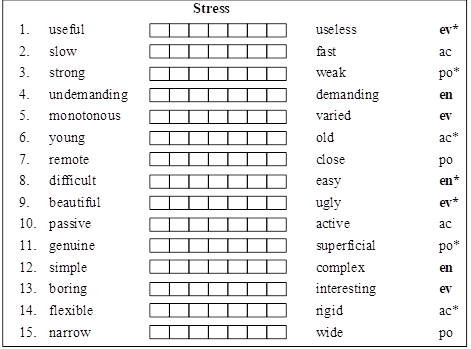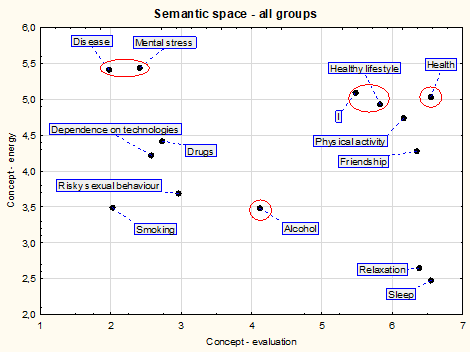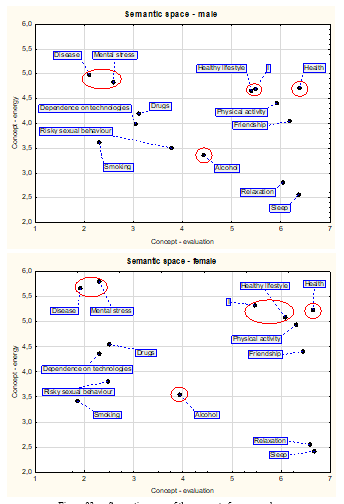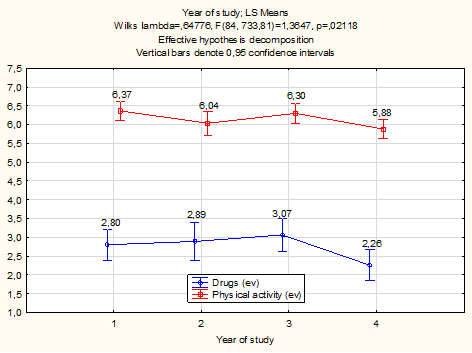Abstract
The paper describes the results of a research study of the attitudes of Czech grammar school students to concepts associated with negative and positive lifestyle aspects. The research method was a modified semantic differential. The semantic differential was optimized and a factor analysis was used to determine the final two-factor structure. Cronbach’s alpha was used to determine reliability r=0.76. The research sample comprised 279 students of various types of grammar schools. Their attitudes by gender were compared by means of the t-test and Mann-Whitney U-Test. Statistically significant differences in both factors (evaluation and energy) were observed in the following concepts: friendship, stress, health, physical activity, dependence on technologies, and healthy lifestyle. Female students perceived most concepts as more difficult than male students, particularly the concept of stress. Among male students, the following concepts were evaluated more positively: risky sexual behaviour, drugs and alcohol. A comparison of students’ attitudes by year of study was performed by means of the ANOVA analysis of variance and Kruskal-Wallis ANOVA, and suggested statistically significant differences in all concepts (p=0.02). The greatest differences were found in the concepts of physical activity and drugs. It was also observed that students’ attitudes were affected by the type of grammar school. In this context, the ANOVA analysis of variance suggested statistically significant differences (p<0.01). The greatest difference (in both factors) was found in the concept of friendship, which students from a church grammar school considered better and more difficult in terms of energy.
Keywords: Students’ attitudeslifestylesemantic differentialfactor analysisANOVAt-test
Introduction
During the course of life, an individual’s opinions and attitudes are affected in the context of personal communication, in the family, school, and also through mass media. Attitudes are important not only for every individual but also for our social life. On an individual level, attitudes affect perception, thinking and behaviour. On an interpersonal level, individuals learn about each other’s attitudes and may try to change the attitudes of other persons (Hewstone & Stroebe, 2006). On an intergroup level, the attitudes to an own group and other groups are the core of intergroup cooperation or conflict. It can be stated that the attitudes of people and their behavioural tendencies shaped by the social conditions during the course of life appear as an important indicator of behaviour and experiencing of all of us.
Problem Statement
Shaping the attitudes to lifestyle in a holistic concept is part of all stages of education. This is consistent with the content of the curriculum for elementary and secondary school students defined by the Czech curricular documents (Hřivnová, 2016). If children’s positive attitudes to health and optimum lifestyle are fostered from a very young age, also using children’s group spirit in kindergarten and higher educational levels, the health of the entire next generation can be improved (Holčík, 2009), which can have a back effect on the previous generations (their parents and grandparents) and future generations (their children). Previous research studies (using the semantic differential as a measurement tool) focused on the attitudes to health and healthy lifestyle among students in the 2nd stage of elementary schools (Chrásková, 2016) and university students (Chrásková & Kvintová, 2016; Chrásková, 2017).
In the next stage of the research the author focused on the attitudes of grammar school students to optimum lifestyle with an emphasis on risk factors (grammar school in the Czech Republic is a general educational institution, preparing students primarily for university).
Research Questions
The basic research question in the present research study was to determine the attitudes of grammar school students to positive and negative aspects of lifestyle. An emphasis was also on the effect of gender on these attitudes, and the development of students’ attitudes to lifestyle in the course of study. Another research issue was the effect of the type of grammar school (traditional, church, sports) on students’ attitudes.
Purpose of the Study
The objective of the research study was to identify the attitudes of grammar school students to concepts associated with the bio-psycho-social aspects of lifestyle in the context of a bipolar selection of risk and protective factors. The research sample comprised grammar school students who prepare for university study. It can thus be assumed that they will be subject to increased requirements in the cognitive, performance and emotional areas. In the research study, the same measurement tool was used as in the research of the attitudes of university students (Chrásková & Kvintová, 2016). The selection of grammar schools during this stage of research ensured involvement of students from all levels of education. Children in the 1st stage of elementary schools were not involved in this long-term research study because the semantic differential approach is not suitable for this particular age group.
Research Methods
In the present research the author adopted a modified semantic differential (Osgood, 1964) according to Pöschl (2011), which is based on the ATER (Chráska sr., 2016) semantic differential and enriched with scales measuring the energy of the concepts (marked en) – see Fig.

The data were obtained from the students by means of the scales of the modified semantic differential and subsequently subjected to a factor analysis in the STATISTICA 12.0 programme in order to assess the anticipated factor structure (Chrásková, 2017) and agreement with the four-factor model.
The research study was conducted using the semantic differential method, which analyses the associations evoked by specific concepts presented to the respondents. The objects were assessed by all respondents subjectively, i.e. how they ‘see’ them. Each concept has a specific cultural meaning, and then additional meanings that vary among the assessors. Sometimes the results differ considerably.
Optimization and description of the semantic differential
Prior to the processing of the results, a control factor analysis of the scales of the semantic differential (Chráska jr., 2014) was performed using the STATISTICA 12 programme (StatSoft, 2013). The analysis was used to select those scales that showed the best agreement with the anticipated factor structure. It turned out that the modified semantic differential did not have the anticipated four-factor structure. The factor analysis revealed a significant effect of only two factors - evaluation (marked ev in the record sheet) and energy (marked en). These two factors showed to be the only relevant correlations with the suggested scales. The remaining two factors - activity (marked ac in the record sheet) and potency (marked po) did not have an adequate factor structure. They were not sufficiently saturated by the proposed scales and therefore, they were no longer used in the study (Chráska jr. & Chrásková, 2016). In the group of grammar school students, the same measurement tool was used as in the previous research of the attitudes of university students (Chrásková, 2017). Similarly, in this previous study, only the factors of evaluation and energy had a corresponding factor structure.
For the calculation of the evaluation of the concept, only scales 1 and 9 were used. For the calculation of the energy of the concept, only scales 4, 8 and 12 were used.
The STATISTICA 12 programme was also used to determine measurement reliability by means of the internal consistency method. The calculated value (Cronbach’s alpha = 0.76) suggested that the measurement of the attitudes using the semantic differential was sufficiently reliable.
Description of the research sample
The structure of the research sample is shown in Table
Description of the research and methods of statistical data processing
To investigate the attitudes of grammar school students, the semantic differential was used; the students were presented with concepts associated with both positive and negative aspects of lifestyle, self-conception and social relationships. For the purposes of the research study, a total of 14 concepts were selected, which the students rated on seven-point scales. The following concepts were used in the order as follows: Friendship; Sleep; I; Stress; Risky sexual behaviour; Drugs; Alcohol; Smoking; Health; Disease; Physical activity; Psychological dependence on technologies; (PC, mobile phone, Internet...); Relaxation, Healthy lifestyle.
The research data obtained were first processed using MS EXCEL and then transformed to STATISTICA 12. In this environment, statistical analyses were performed. The t-test and the ANOVA analysis of variance were used, and whenever the data did not have normal distribution, the non-parametric Mann-Whitney U-Test and Kruskal-Wallis ANOVA were applied.
Findings
To clearly show the attitudes of grammar school students with respect to their evaluation, energy, and semantic proximity, all concepts were included in the form of semantic spaces (see Figure
Attitudes of grammar school students to selected lifestyle risk factors
The semantic space of all concepts (see Fig.

Attitudes of grammar school students to selected risk lifestyle factors by gender
To show the attitudes to selected concepts by gender, separate semantic spaces were developed (see Figure
These spaces show that the position of individual groups of concepts is similar in both genders. They only differ in their proximity; more often in terms of energy expenditure than evaluation. Generally, female students consider the concepts to be more difficult than male students (particularly evident in the case of stress).

A comparison of the attitudes of grammar school students by gender by means of the t-test is shown in Table
A statistical comparison of evaluation and energy expenditure in the group of male and female students suggested significant differences in both dimensions in the following concepts: friendship, stress, health, physical activity, dependence on technologies, and healthy lifestyle.
In terms of evaluation of the concepts, statistically significant differences were observed in the concepts of sleep and relaxation (better evaluated by female students), risky sexual behaviour, drugs, alcohol (better evaluated by male students). In terms of difficulty of the concepts, significant differences were observed in the concepts of I and disease; both considered more difficult by female students.
Attitudes of grammar school students to selected risk lifestyle factors by year of study
The ANOVA analysis of variance (see Table

Attitudes of grammar school students to selected risk lifestyle factors by type of grammar school
In the present research the authors also focused on whether the attitudes of grammar school students were affected by the type of grammar school. The research sample comprised 176 students from a traditional grammar school, 68 students from a church grammar school, and 34 students from a sports grammar school (see Table
Conclusion
The results of the present research show that the attitudes of grammar school students to the concepts meet the assumptions and general expectations regarding the risk and protective aspects of an optimum lifestyle (HBSC, 2016; Health 2020, 2014). A comparison of the attitudes by gender and year of study based on statistical data processing showed differences only in some concepts. In terms of gender, statistically significant differences in both factors (evaluation and energy) were observed in the following concepts: friendship, stress, health, physical activity, dependence on technologies, and healthy lifestyle. It can also be stated that female students perceive the concepts as more difficult than male students. This is particularly evident for the concept of stress. Female students showed statistically significantly better evaluation of the concepts of sleep and relaxation. Among male students, the following concepts are evaluated more positively: risky sexual behaviour, drugs and alcohol. If these lifestyle risk aspects are considered by male students in this way already during secondary education, this attitude is likely to occur not only during tertiary education but also later in life.
Interestingly, a comparison of the semantic space of the concepts in grammar school students with the semantic space of the concepts in university students (Chrásková, 2017) suggests a similar distribution of the concepts. Only for the concepts of alcohol and risky sexual behaviour, university students suggested worse evaluation and a higher degree of perceived difficulty. A decrease in energy expenditure concerning the concept of stress was observed among university students (which means that they cope better with stressful situations). At the same time, the evaluation of this concept remained identical with grammar school students. A comparison of students’ attitudes by year of study was performed by means of the ANOVA analysis of variance and suggested statistically significant differences in all concepts (p=0.02). However, the greatest differences were observed in the concepts of physical activity and drugs, where a significant decrease in the evaluation of these concepts was observed in year four.
In the present research the authors also investigated the effect of the type of grammar school on students’ attitudes. The research sample comprised students from a traditional, church and sports grammar school. The ANOVA analysis of variance suggested statistically significant differences (p<0.01) in the perception of all concepts between students from various types of grammar schools. It can therefore be stated that the type of grammar school is a significant aspect in the development of students’ attitudes. The greatest difference (in both factors) was found in the concept of friendship, which students from the church grammar school considered better and more difficult in terms of energy compared with students from other types of grammar schools.
An alarming finding of the present research is the perception of the concept of alcohol, because of all risk lifestyle factors this concept has the most positive evaluation among grammar school students and achieves slightly above-average evaluation. This may also be affected by the fact that contrary to the relatively extensive anti-smoking campaign in the Czech Republic, a similar campaign aimed at use and overuse of alcohol is missing.
An important aspect in shaping of the attitudes of students of this age to an optimum lifestyle is institutional education. A similar opinion was expressed by elementary school headteachers (Hřivnová, 2017); for example 95% of headteachers think that it is important to educate children in the area of health education, 70% of headteachers believe that this education might have a society-wide impact in the form of decreased mortality rate as a result of lifestyle diseases and a decrease in risky behaviour, and 62% of headteachers are convinced that it makes sense to continue health education in grammar schools and other secondary schools.
Acknowledgments
The author would like to thank the Department of Anthropology and Health Education, Faculty of Education, Palacký University in Olomouc for funding the research study.
References
- Chráska, M. jr. & M. Chrásková (2016). Semantic Differential and its Risks in the Measurement of Students’ Attitudes. Procedia - Social and Behavioral Sciences Elsevier, 820-829.
- Chráska, M. jr. (2014). The Application of a Factor Analysis to Verify the Factor Structure of Modified Semantic Differentials for Measuring Students' Attitudes. Albena: International Multidisciplinary Scientific Conferences on Social Sciences & Arts. SGEM. Volume 1. pp. 429-440.
- Chráska, M. sr. (2016). Metody pedagogického výzkumu. 2. aktual. vyd. Praha: Grada.
- Chrásková, M. (2016). Attitudes of Students in 2nd Stage of Elementary Schools to Health Promotion in the Context of Health Literacy. In International Multidisciplinary Scientific Conference on Social Sciences and Arts SGEM 2016. Albena: SGEM. pp. 585-592.
- Chrásková, M. & J. Kvintová (2016). A Reflection of the Attitudes of Future Teachers to the Psychosocial Aspects of Health in Relation to their Coping Strategies. ICERI2016 Proceedings. Madrid: IATED. pp. 4606-4617. Retrieved from DOI 10.21125/iceri.2016.2092
- Chrásková, M. (2017). Mezikulturní rozdíly v postojích vysokoškolských studentů ke zdraví v kontextu pedagogické antropologie. In Cichá, M. (ed.) Pedagogická antropologie v podmínkách současné školy. Olomouc: Univerzita Palackého v Olomouci, 2017. pp .181-205.
- HBSC. (2016). Mezinárodní zpráva o zdraví a životním stylu dětí a školáků na základě výzkumu studie Health Behaviour in School-Aged Children realizované v roce 2014. Olomouc: Univerzita Palackého.
- Health 2020. (2014). National strategy for health protection and promotion and disease prevention. (Zdraví 2020 – Národní strategie ochrany a podpory zdraví a prevence nemocí). Praha: Ministerstvo zdravotnictví České republiky.
- Hewstone, M. & W. Stroebe (2006). Sociální psychologie. Praha: Portál.
- Holčík, J. (2009). Zdravotní gramotnost a její role v péči o zdraví. Brno: MSD.
- Hřivnová, M. (2016). Health Literacy in Pupils in the Context of Research of Resulting Curriculum of Health Educatiıon. The Anthropologist. 24(1), 277-283.
- Hřivnová, M. (2017). Podpora zdraví na jednotlivých úrovních kurikula vzdělávací soustavy v České republice. In Cichá, M. a kol. Pedagogická antropologie v podmínkách současné školy. Olomouc: Univerzita Palackého v Olomouci, 2017. pp. 65-90.
- Osgood, Ch. E. (1964). Semantic differential technique in the comparative study of cultures, American Anthropologist. 66(3), 171-200, Part 2.
- Pöschl, R. (2011). Postoje žáků ke škole. Dotazník pro žáky. Praha: Národní ústav odborného vzdělávání.
- StatSoft, Inc. (2013). STATISTICA (data analysis software system), version 12, www.statsoft.com.
Copyright information

This work is licensed under a Creative Commons Attribution-NonCommercial-NoDerivatives 4.0 International License.
About this article
Publication Date
14 January 2019
Article Doi
eBook ISBN
978-1-80296-052-5
Publisher
Future Academy
Volume
53
Print ISBN (optional)
-
Edition Number
1st Edition
Pages
1-812
Subjects
Education, educational psychology, counselling psychology
Cite this article as:
Chrásková, M. (2019). Attitudes Of Grammar School Students To Selected Lifestyle Risk Factors. In Z. Bekirogullari, M. Y. Minas, & R. X. Thambusamy (Eds.), ICEEPSY 2018: Education and Educational Psychology, vol 53. European Proceedings of Social and Behavioural Sciences (pp. 409-419). Future Academy. https://doi.org/10.15405/epsbs.2019.01.39

